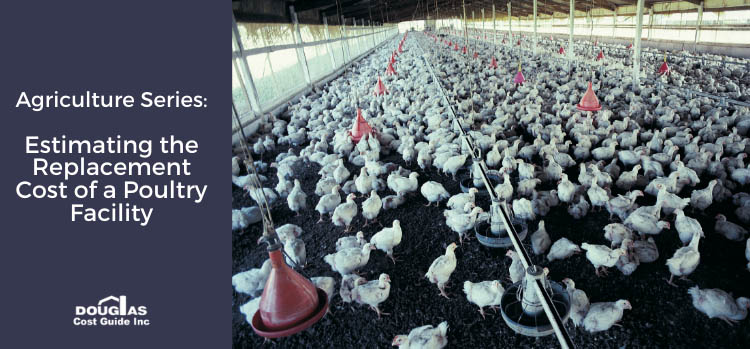When a poultry barn suffers irreparable damage, the farm owner may become embroiled in complicated negotiations with the insurance company. Too often, inexperienced insurance adjusters oversimplify the estimation process.
That’s why it’s essential to use the Douglas Agricultural Cost Guide to arrive at an accurate rebuild estimate. The Douglas system uses the most current data and accounts for the wide-reaching differences that elude oversimplified square-footage calculations. The Douglas Agricultural Cost Guide can help eliminate some of the guesswork when estimating the rebuild cost of a poultry facility.
Essential Factors When Estimating the Replacement Cost of a Poultry Facility
Insurance adjusters with limited experience sometimes believe construction boils down to a basic equation. They may think that multiplying square-footage areas by labour rates and material costs tallies up to the total cost. If you are in the agricultural sector, you know that nothing could be further from the truth.
A modern poultry facility rebuild cost estimation starts with basic measurements that include wall height, roof design, materials, foundation type, local labour costs, and, yes, square footage. But beyond the standardized data, it’s crucial to understand poultry farmers have different goals that require vastly different facilities. The following examples highlight this point.
Broiler Barns:
These facilities are generally constructed with the idea that broiler chickens will occupy them for approximately 6-9 weeks. When rebuilding a broiler barn, these facilities must keep an eye on maximized space for the chickens to walk around exercise along with adequate space for eating and accessibility to water, as well as ventilation and heating requirements.
Breeder Barns:
These facilities emphasize comfortable egg-laying environments. Unlike broiler barns, the build is geared toward egg collection systems such as nests, egg belts / conveyors and roosting areas. The design is inherently different from broiler barns.
Egg-Producing Barns:
Poultry barns that focus on commercial egg production are typically what people outside the industry imagine. These facilities are designed for maximum egg-laying and collection efficiency, as well as maximizing the comfort of the hen.
Free Range:
The trend toward organic, free-range chickens has changed the way many operations structure their facilities. To qualify as a free-range farm, outdoor access and movement thresholds must be met. This can be a game-changer in terms of indoor-outdoor space and structures to protect chickens from predators.
It’s also important to note that poultry facilities employ different fresh-air delivery systems, cleaning methods, and cleaning infrastructure. When an inexperienced insurance adjuster points to a simplified rebuild estimate, it’s time to turn to the Douglas Agricultural Cost Guide for improved accuracy.
Douglas Agricultural Cost Guide Accurately Estimates All Types of Poultry Facilities
It’s not uncommon for agriculture professionals to be concerned a rebuild could run over an insurance company’s estimate. The Douglas Agricultural Cost Guide brings 30 years of experience to every estimate and is updated with the most recent data available. Your rebuild will enjoy a reliable budget by using the latest data and accounting for the wide-reaching poultry or egg production differences.

